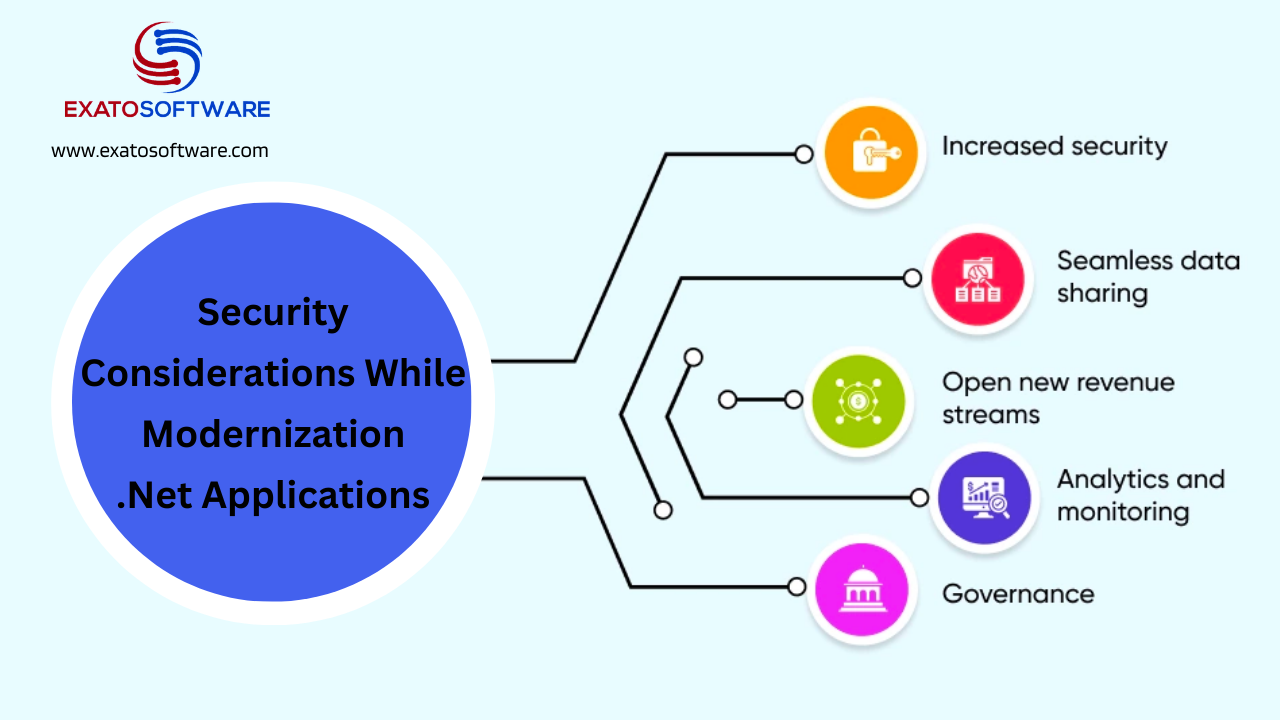When modernizing .NET applications, several security considerations need attention to ensure that the modernized applications are secure and resilient to potential threats. Here are some key security considerations:
1. Secure Authentication and Authorization:
a. Ensure that authentication mechanisms are modern and robust, such as using OAuth 2.0 or OpenID Connect for authentication.
b. Implement proper authorization mechanisms to control access to resources within the application.
c. Use strong authentication factors where necessary, such as multi-factor authentication (MFA), especially for sensitive operations or data access.
Here’s a simplified example of how you might implement OAuth 2.0 authorization in a .NET web application using the Authorization Code Flow and the OAuth 2.0 client library for .NET:
```csharp
// Install the OAuth 2.0 client library via NuGet Package Manager
// Install-Package OAuth2.Client
using OAuth2.Client;
using OAuth2.Infrastructure;
using OAuth2.Models;
// Define OAuth 2.0 client settings
var client = new FacebookClient(new RequestFactory(), new RuntimeClientConfiguration
{
ClientId = "Your_Client_ID",
ClientSecret = "Your_Client_Secret",
RedirectUri = "Your_Redirect_URI"
});
// Redirect users to the OAuth 2.0 authorization server's authentication endpoint
var authorizationUri = client.GetLoginLinkUri();
// Handle callback after user grants permission
// Example ASP.NET MVC action method
public async Task<ActionResult> OAuthCallback(string code)
{
// Exchange authorization code for access token
var token = await client.GetUserInfoByCodeAsync(code);
// Use the access token to make authorized API requests to the third-party API
var apiResponse = await client.GetUserInfoAsync(token.AccessToken);
// Process the API response
// ...
}
```
In this example, `FacebookClient` is used as an OAuth 2.0 client for accessing the Facebook API. You would need to replace it with the appropriate OAuth 2.0 client implementation for your specific OAuth 2.0 provider.
2. Data Protection:
a. Employ encryption mechanisms to protect sensitive data, both at rest and in transit.
b. Utilize encryption libraries and algorithms provided by the .NET framework or third-party libraries that are well-vetted and secure.
c. Consider using features like Transparent Data Encryption (TDE) for databases to encrypt data at the storage level.
Here’s a simple example of connecting to an encrypted SQL Server database using ADO.NET in a C# .NET application:
```csharp
using System;
using System.Data.SqlClient;
class Program
{
static void Main(string[] args)
{
string connectionString = "Data Source=YourServer;Initial Catalog=YourDatabase;Integrated Security=True";
using (SqlConnection connection = new SqlConnection(connectionString))
{
try
{
connection.Open();
Console.WriteLine("Connected to the database.");
// Perform database operations here
}
catch (Exception ex)
{
Console.WriteLine("Error: " + ex.Message);
}
}
}
}
```
In this example, replace `”YourServer”` and `”YourDatabase”` with the appropriate server and database names.
When the application connects to the encrypted SQL Server database, SQL Server automatically handles the encryption and decryption of data, ensuring that data remains encrypted at rest and decrypted in memory while it’s being accessed by the application.
It’s important to note that TDE protects data only when it’s at rest. Data is decrypted in memory when accessed by authorized users or applications. To further enhance security, consider implementing additional security measures such as encrypted communication channels (e.g., using SSL/TLS) and access controls to limit access to sensitive data.
3. Secure Communications:
a. Use HTTPS for all communications between clients and servers to ensure data integrity and confidentiality.
b. Disable outdated or insecure protocols (e.g., SSLv2, SSLv3) and only support modern cryptographic protocols and cipher suites.
4. Input Validation and Output Encoding:
a. Implement robust input validation to prevent injection attacks such as SQL injection, cross-site scripting (XSS), and command injection.
b. Apply output encoding to prevent XSS attacks by ensuring that user-supplied data is properly encoded before being rendered in HTML or other contexts.
Here’s how you can apply input validation and output encoding in a .NET application to mitigate these security risks:
Input Validation to Prevent SQL Injection:
Input validation ensures that user-supplied data meets the expected format and type before processing it.
Parameterized queries or stored procedures should be used to interact with the database, which inherently protects against SQL injection attacks.
Example (C#/.NET with parameterized query):
```csharp
using System.Data.SqlClient;
string userInput = GetUserInput(); // Get user input from form or other sources
string queryString = "SELECT * FROM Users WHERE Username = @Username";
using (SqlConnection connection = new SqlConnection(connectionString))
{
SqlCommand command = new SqlCommand(queryString, connection);
command.Parameters.AddWithValue("@Username", userInput); // Use parameters to avoid SQL injection
connection.Open();
SqlDataReader reader = command.ExecuteReader();
// Process the query result
}
```
Output Encoding to Prevent XSS Attacks:
Output encoding ensures that any user-controlled data displayed in the application's UI is properly encoded to prevent malicious scripts from being executed in the browser.
Example (C#/.NET with Razor syntax for ASP.NET Core MVC):
```html
<!-- Razor syntax in a CSHTML file -->
<p> Welcome, @Html.DisplayFor(model => model.Username) </p>
```
In this example, `@Html.DisplayFor()` automatically encodes the user-supplied `Username` to prevent XSS attacks.
For client-side JavaScript, consider using Content Security Policy (CSP) headers to restrict the sources from which scripts can be executed.
Other Considerations:
– Implement input validation at both client-side and server-side to provide a multi-layered defense.
– Use frameworks and libraries that provide built-in protection against common security vulnerabilities.
– Regularly update and patch software dependencies to mitigate newly discovered vulnerabilities.
– Educate developers about secure coding practices and security best practices.
By implementing input validation and output encoding consistently throughout your application, you can significantly reduce the risk of SQL injection and XSS attacks. However, it’s important to remember that security is an ongoing process, and vigilance is required to address emerging threats and vulnerabilities.
5. Error Handling and Logging:
a. Implement secure error handling mechanisms to avoid exposing sensitive information in error messages.
b. Log security-relevant events and errors for auditing and monitoring purposes, while ensuring that sensitive information is not logged in clear text.
6. Session Management:
a. Implement secure session management practices, such as using unique session identifiers, session timeouts, and secure session storage mechanisms.
b. Invalidate sessions securely after logout or inactivity to prevent session hijacking attacks.
7. Security Testing:
a. Perform thorough security testing, including penetration testing and vulnerability assessments, to identify and remediate security weaknesses.
b. Utilize security scanning tools and code analysis tools to identify common security vulnerabilities early in the development lifecycle.
8. Third-Party Dependencies:
a. Regularly update and patch third-party dependencies, including libraries, frameworks, and components, to address security vulnerabilities.
b. Evaluate the security posture of third-party dependencies before integrating them into the application.
9. Secure Configuration Management:
a. Securely manage application configuration settings, including secrets, connection strings, and cryptographic keys.
b. Avoid hardcoding sensitive information in configuration files and use secure storage mechanisms such as Azure Key Vault or environment variables.
10. Compliance and Regulatory Requirements:
a. Ensure that the modernized application complies with relevant security standards, regulations, and industry best practices, such as GDPR, HIPAA, PCI DSS, etc.
b. Implement appropriate security controls and measures to address specific compliance requirements applicable to the application and its data.
By addressing these security considerations throughout the modernization process, developers can enhance the security posture of .NET applications and mitigate potential security risks effectively.



